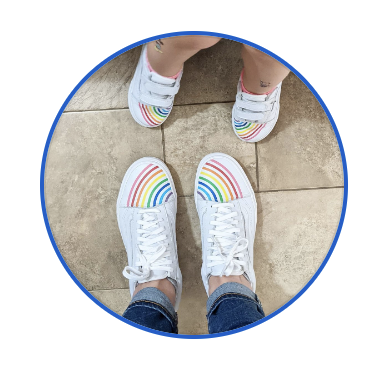This post may contain affiliate links. Every link is hand-selected by our team, and it isn’t dependent on receiving a commission. You can view our full policy here.
I’ve gone back and forth on writing this post. Part of me feels like I have no place writing it — what authority do I have on the topics of gun control and school violence in America?! — but a larger part of me can’t stay quiet. I write to process things; here, I’m doing so publicly, because I need help understanding the best way forward. I’ve got to take action, and I’d like to start a conversation with you about it. If LBW is going to be a place devoted to making each day better, it can’t just be a source for head-in-the-sand escapism; sometimes, it means confronting the ugly truths of the world and taking action to make tomorrow brighter.
At first, I didn’t want to believe it. When a coworker said there had been a school shooting, I figured she had to be wrong. Or grossly overstating the facts. But there it was, on the main page of every news site: On Valentine’s Day, teenager Nikolas Cruz opened fire at his former high school in Parkland, Florida, killing 17 people. It’s the kind of tragedy that guts you twice — first, that it happened; second, that it happened again. (Harvard research shows mass killings — as in four or more people murdered — have gone from one every 172 days in the U.S. to one every 64 days, at least as of 2014.) It’s heartbreaking, and while I want to give the families space to mourn, I also want to take measures so that no family goes through this again. It seems like an impossible feat, which is why I’m reading every article and taking in every perspective I can. These are my biggest takeaways so far.
It Shouldn’t Be So Easy To Get Your Hands On An AR-15.
I’ll be completely honest: I don’t know anything about guns. With each attack though, I’ve gradually learned more and more, and the more I read, the more confused I am about how widely accessible AR-15’s are. They’re considered the most popular gun in America, according to the NRA, but what confuses me is how easy they are to buy.
You have to be 21 or older to purchase a handgun from a firearms dealer, according to federal law, but you can be as young as 18 to buy a semiautomatic rifle. On top of that, Florida’s three-day waiting period for handgun purchases doesn’t apply to the AR-15. As long as your record’s clean of felonies and domestic abuse convictions, as well as a few other exceptions, you just have to wait for the background check to clear and you can walk out of the store with one, The New York Times reported.
Wait, WHAAAAT?!
That same Times article goes on to explain that Congress banned assault rifles (including the AR-15) from 1994 to 2004, but when the ban expired, it left the states to determine their stance on them.
What That Means To Me: Look up the laws in your area, and if you disagree with them, contact your senators and congresspeople to demand change. (The Giffords Law Center has a thorough database on gun laws in every state.) Here’s a list of phone numbers and Twitter handles for each state’s U.S. senators. If they’re unwilling to make change, take note — and vote for someone else next term.
Who Really Needs High Capacity Magazines?
This was something I never really thought about until the Sandy Hook shooting, but it’s stuck with me ever since: Why does the average person need high capacity magazines, so they can fire off more bullets without needing to stop and reload? I understand the convenience factor of not having to reload, but I fail to see the situations in life when it’s necessary for most people — and outweighs the potential threat. I can see a counterargument — why ban something because you can’t trust people? Should we ban Tide Pods too? Or pen caps, which roughly 100 people die after choking on each year? (If that stat’s to be believed.)
But after hearing these parents talk about how stopping to reload saved some first graders’ lives, and how many parents are haunted by that question: Could my child have survived, had Adam Lanza had smaller magazines on his guns? It’s easy to let the what-ifs get to you in those scenarios, but smaller magazines seems like a reasonable change.
After all, pen caps now have holes in the top so that if you do choke on one, it’s easier to breathe until you can get it removed.
Eight states and D.C. ban high-capacity magazines. You can look at those laws here.
Mental Health Should Be Part Of The Equation.
It’s not the only part, for sure, but it’s a critical part. We had health class in school, but at least in my experience, it was all about the Birds & Bees and enduring old VHS movies about the horrors of drugs, alcohol, peer pressure and anorexia. We didn’t really touch on anxiety, depression, or dealing with those feelings, and I only saw a guidance counselor when I was beating down his/her door to learn about scholarships. Hopefully my experience is totally rare and unrelatable to most people, but I worry it isn’t. There’s a lot of talk about improving mental health resources, but what does that look like?
These 10 suggestions from a psychology professor — which include developing students’ emotional intelligence, boosting funding for on-campus psychologists and social workers, and having a text message anonymous tip service for students to report when they think someone’s behavior is troubling — sound like a great start.
As someone who grew up in a post-Columbine school, fences and lockdown drills aren’t enough. Increased security measures have to be balanced with measures to check in on people’s wellbeing.
I’m Not Taking Offense To The ‘Thoughts & Prayers’ Criticisms.
As a Christian, I get it if seeing all of the posts decrying people sending “thoughts and prayers” feels like a punch in the stomach. Or rather, an assault on your beliefs. But I don’t take it that way. Yes, if you believe in prayer, you should pray, but you shouldn’t just pray — or tell someone you’ll pray — and leave it at that. That’s the heart of the complaint right now, and honestly, it’s in line with James 2:14-16. “What good is it, my brothers, if someone says he has faith but does not have works? Can that faith save him? 15 If a brother or sister is poorly clothed and lacking in daily food, 16 and one of you says to them, ‘Go in peace, be warmed and filled,’ without giving them the things needed for the body, what good is that?” Prayer doesn’t absolve you from being an active participant in this world, and an agent for its change (which is something I need to be better at practicing myself).
It reminds me of that joke about the man who’s drowning and prays for God to save him, then a boat comes by and people urge him to get in. He declines, saying God will save him. Another boat appears, offering to rescue him, and he declines again. Eventually, he drowns and appears before God, exasperated, demanding to know why the big man didn’t save his life. “Didn’t you see the two boats I sent you?!” God replies.
Yes, it’s a joke, and yes, I’m terribly paraphrasing it, but the sentiment remains: Faith without action is hollow. Let’s keep praying, but how can we supplement that with action to prevent this from happening again?
We Have Until March 24 To Clarify To Congress EXACTLY What We Want.
I am amazed by the strength, resilience, and determination of the students at Marjory Stoneman Douglas High. They certainly didn’t ask to be pushed into the national spotlight, just as assuredly as they didn’t ask for such a tragedy to rip apart their lives. Yet still, students from the school and across the country have banded together to deliver a statement to the U.S., saying that if now wasn’t the time to talk about ending gun violence, March 24th would be. It’s the date of the March For Our Lives, organized to show the president and Congress how passionate we are about ending mass shootings.
Students nationwide are planning marches in major cities everywhere on that day, all urging Washington to pass legislation that makes schools safer for kids everywhere. It’s a huge opportunity to push for change — and a huge chance to help direct that change. If we can tell Congress exactly what types of changes we want — beyond ‘make schools safer’ — we have a better shot at establishing laws that delve beyond adding more metal detectors to schools. Easier said than done, sure, but it’s important to talk about.
You can learn more the March For Our Lives here.
Photo by Rene Böhmer on Unsplash




